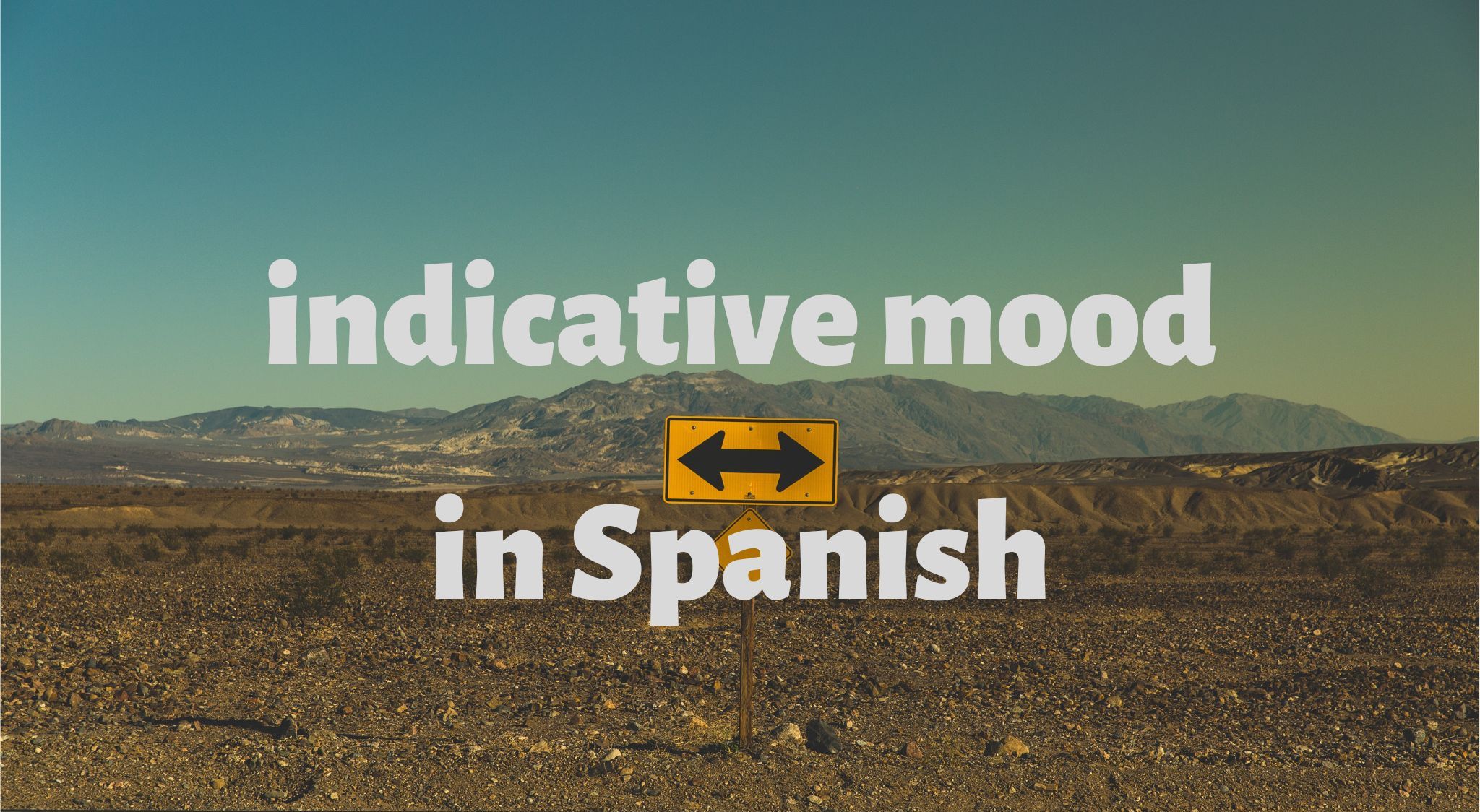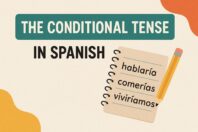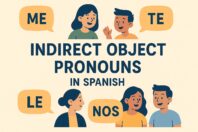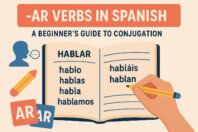Indicative Spanish: A full guide to the indicative mood

Get our free email course, Shortcut to Conversational.
Have conversations faster, understand people when they speak fast, and other tested tips to learn faster.
More infoThe indicative mood is the most common mood in the Spanish language, so logically it’s the first Spanish mood that learners encounter. Becoming familiar with indicative Spanish therefore lays the groundwork for learning all of the moods and tenses.
That’s why today we bring you this post with everything you need to know about the Spanish indicative, from the basics such as “what is a Spanish mood?,” to an overview of the indicative Spanish tenses, along with all the indicative conjugation tables for regular verbs.
Are you in the mood to get started? Let’s go!
The basics: What is a mood?
Firstly, from a grammatical perspective, what is a mood? Isn’t indicative Spanish a kind of verb tense? Well, not quite, but they are indeed related.
While verb tenses frame the actions in specific moments, moods express the attitude of the speaker towards the action. Such attitudes range between certainty, urgency, possibility, or obligation, for example.
In Spanish, there are three moods: the indicative, the subjunctive, and the imperative. Within each mood, specific verb tenses place the actions within timeframes from the past to the present to the future.
In this post we’ll focus solely on the most common of the three, which is the indicative mood in Spanish. Take a look at our posts on the subjunctive and the imperative for deeper discussions on the other two moods. For reference, the names for these three moods in Spanish are indicativo, subjuntivo, and imperativo.
When to use indicative Spanish
The key use of the Spanish indicative is for factuality. When we use the indicative in Spanish, our attitude is that our message is factual or extremely likely.
The indicative mood is therefore usually used to talk about facts, habits, or descriptions in the past, present, or future. The Spanish conditional tenses also fall within the indicative mood.
Indicative Spanish: Tenses and conjugations
As we’ve already mentioned, the indicative mood encompasses various tenses. In other words, we can’t talk of a single Spanish indicative tense, as there are actually ten different indicative tenses! Of these, five indicative conjugations take unique endings, while the other five indicative tenses have compound conjugations based on the participle.
In the following sections, we’ll introduce each Spanish indicative tense. In addition to the ten indicative tenses, we’ll also include the past and present progressive forms since they’re also built on the indicative conjugations of the verb estar.
Although we won’t go into irregular verb conjugation, we’ll at least provide conjugation tables to show the regular verb endings for the three groups of Spanish infinitives. As example verbs for each of the three conjugation groups, we’ll provide all the indicative conjugations for amar, comer, and vivir.
For additional info on each tense, we’ll include links to our other posts where we talk about each one in more detail. For a broader overview including all three moods, we recommend our post on all the Spanish verb tenses.
Now, let’s take a look at each Spanish indicative tense, including explanations and the regular verb conjugation tables, providing a comprehensive reference of indicative Spanish.
Simple present
The simple present, known as presente in Spanish, is used to describe and talk about facts and actions in the present. Present indicative Spanish is probably the most useful tense to know, since it’s used constantly in everyday settings.
Most learners should be familiar with the Spanish present tense verb endings shown below. Take a look at the present tense Spanish conjugation table here, and make sure you’re comfortable with all the bolded Spanish present tense endings.
For more info, check out our post on the present indicative tense, including an intro to the Spanish present endings for irregular verbs. We also have posts listing the most important verbs to know for each group: -ar verbs, -er verbs, and -ir verbs, as well as a lesson on how to conjugate the most common irregular verbs: the stem-changing verbs.
| Subject | -ar verb conjugation: amar | -er verb conjugation: comer | -ir verb conjugation: vivir |
| Yo | Amo | Como | Vivo |
| Tú | Amas | Comes | Vives |
| Él, Ella, Usted | Ama | Come | Vive |
| Nosotros, Nosotras | Amamos | Comemos | Vivimos |
| Vosotros, Vosotras | Amáis | Coméis | Vivís |
| Ellos, Ellas, Ustedes | Aman | Comen | Viven |
Imperfect past
In contrast to English, with its single simple past tense, we have two simple past tenses in indicative Spanish. The imperfect indicative tense, known as the pretérito imperfecto in Spanish, is often simply referred to as the Spanish imperfect tense.
This tense is used to talk about actions that used to happen or actions that were in progress or interrupted by another action. Check out our beginner guide to the Spanish imperfect tense for more details.
In the meantime, here’s the conjugation table for regular verbs in the Spanish indicative imperfect tense:
| Subject | -ar verb conjugation: amar | -er verb conjugation: comer | -ir verb conjugation: vivir |
| Yo | Amaba | Comía | Vivía |
| Tú | Amabas | Comías | Vivías |
| Él, Ella, Usted | Amaba | Comía | Vivía |
| Nosotros, Nosotras | Amábamos | Comíamos | Vivíamos |
| Vosotros, Vosotras | Amabais | Comíais | Vivíais |
| Ellos, Ellas, Ustedes | Amaban | Comían | Vivían |
Preterite
The other simple past tense in indicative Spanish is known as the pretérito indefinido. It’s sometimes simply referred to as the simple past tense in English, but to keep it straight against the imperfect it’s usually referred to by its direct translation of preterite.
The Spanish preterite used to talk about actions and describe events that took place in the past and are finished. This preterite indicative tense is thus used to emphasize that the action has already been completed. Check out our detailed post for a full explanation of preterite Spanish, or our comparison post to understand when to use preterite vs imperfect.
Here’s our preterite conjugation table for regular verbs. Check out our other post for irregular preterite conjugation.
| Subject | -ar verb conjugation: amar | -er verb conjugation: comer | -ir verb conjugation: vivir |
| Yo | Amé | Comí | Viví |
| Tú | Amaste | Comiste | Viviste |
| Él, Ella, Usted | Amó | Comió | Vivió |
| Nosotros, Nosotras | Amamos | Comimos | Vivimos |
| Vosotros, Vosotras | Amasteis | Comisteis | Vivisteis |
| Ellos, Ellas, Ustedes | Amaron | Comieron | Vivieron |
Simple future
The indicative simple future tense is known as the futuro imperfecto in Spanish.
This indicative future tense is used for actions that are likely to happen in the future, or that we expect. Thus, it’s usually used for beliefs about the future, as well as for plans.
Many Spanish learners are also familiar with the simple equivalent of “going to” in Spanish. That ir a + infinitive construction involves conjugating ir in different tenses, so it’s also often in the indicative mood.
The third way to talk about the future in the indicative mood is with the future perfect tense, which we’ll go into below. Check out our post on future tense Spanish for more details on all three. For now, we’ll just leave you with the futuro imperfecto conjugation table:
| Subject | -ar verb conjugation: amar | -er verb conjugation: comer | -ir verb conjugation: vivir |
| Yo | Amaré | Comeré | Viviré |
| Tú | Amaras | Comerás | Vivirás |
| Él, Ella, Usted | Amará | Comerá | Vivirá |
| Nosotros, Nosotras | Amaremos | Comeremos | Viviremos |
| Vosotros, Vosotras | Amaréis | Comeréis | Viviréis |
| Ellos, Ellas, Ustedes | Amarán | Comerán | Vivirán |
Conditional
This is the last simple tense within indicative mood Spanish, known as condicional simple.
The conditional is used to talk about actions that are set to happen if a certain condition is met. Although the conditional actions are hypothetical at the time of speaking, the factuality principle of the indicative still applies, since it is certain that the action expressed with the conditional will occur if the precondition is fulfilled. So although some sources may refer to the conditional mood in Spanish, it’s still technically part of the indicative mood.
The conditional form is also commonly used for making polite requests, equivalent to using would, could, or should in English. This tense admittedly takes some practice to get the hang of, as far as when to use it. We recommend our in-depth post on both Spanish conditional tenses for a full explanation.
Here’s the simple conditional tense Spanish conjugation for regular verbs:
| Subject | -ar verb conjugation: amar | -er verb conjugation: comer | -ir verb conjugation: vivir |
| Yo | Amaría | Comería | Viviría |
| Tú | Amarías | Comerías | Vivirías |
| Él, Ella, Usted | Amaría | Comería | Viviría |
| Nosotros, Nosotras | Amaríamos | Comeríamos | Viviríamos |
| Vosotros, Vosotras | Amaríais | Comeríais | Viviríais |
| Ellos, Ellas, Ustedes | Amarían | Comerían | Vivirían |
Progressive forms
The Spanish progressive is a grammatical form for talking about ongoing actions. The progressive is not a tense on its own. It’s rather constructed of the verb estar conjugated in a given tense depending on the timeframe it refers to, along with the gerund of the action verb.
We’ve nonetheless decided to include the most common progressive forms here, since they fit the principles of factuality of indicative Spanish. We’ll give brief explanations of each, along with the conjugation tables for the three regular verb groups.
Note that this same application of indicative Spanish applies to other constructions like the future progressive, or the voy à construction we mentioned above within our explanation of the simple future tense.
Present progressive
The present progressive is used to talk about actions happening at the moment.
This construction is formed of the verb estar in the simple present, and a gerund. Gerunds are verb forms that end in -ando or -iendo, depending on the verb group, as shown in the table below. This verb form is called the gerundio in Spanish.
We recommend our detailed post for a full explanation of present progressive Spanish, including a full lesson on the gerund.
| Subject | -ar verb conjugation: amar | -er verb conjugation: comer | -ir verb conjugation: vivir |
| Yo | Estoy hablando | Estoy corriendo | Estoy viviendo |
| Tú | Estás hablando | Estás corriendo | Estás viviendo |
| Él, Ella, Usted | Está hablando | Está corriendo | Está viviendo |
| Nosotros, Nosotras | Estamos hablando | Estamos corriendo | Estamos viviendo |
| Vosotros, Vosotras | Estáis hablando | Estáis corriendo | Estáis viviendo |
| Ellos, Ellas, Ustedes | Están hablando | Están corriendo | Están viviendo |
Past progressive
The past progressive is used to express the continuity of an action in the past.
It is formed of the verb estar in the imperfect tense, and a gerund. This gerund is the same verb form we saw with the present progressive, shown in our conjugation table below in the three forms for the three verb groups.
We explain more on this way of referring to the past in our post on past progressive Spanish.
| Subject | -ar verb conjugation: amar | -er verb conjugation: comer | -ir verb conjugation: vivir |
| Yo | Estaba hablando | Estaba corriendo | Estaba viviendo |
| Tú | Estabas hablando | Estabas corriendo | Estabas viviendo |
| Él, Ella, Usted | Estaba hablando | Estaba corriendo | Estaba viviendo |
| Nosotros, Nosotras | Estábamos hablando | Estábamos corriendo | Estábamos viviendo |
| Vosotros, Vosotras | Estabais hablando | Estabais corriendo | Estabais viviendo |
| Ellos, Ellas, Ustedes | Estaban hablando | Estaban corriendo | Estaban viviendo |
Compound indicative tenses
These last five tenses are all considered to be unique indicative conjugations, even though their compound construction is built on the first five we saw above: for each compound tense, the auxiliary verb haber is conjugated to one of the simple tenses, and followed by the participle of the action verb.
You’ll therefore see the same regular verb participles in each of the following conjugation tables. Check out our post on how to form the Spanish past participle for an explanation of irregular Spanish participles.
Present perfect
The Spanish present perfect tense is used to talk about actions or events that happened in the recent past. It’s called the pretérito perfecto in Spanish.
This indicative tense is formed with the verb haber conjugated in the present indicative, followed by the past participle.
See our post on present perfect Spanish for a deeper explanation of this tense, including more on its structure and on how to form the participle. Here’s the present perfect conjugation table:
| Subject | -ar verb conjugation: amar | -er verb conjugation: comer | -ir verb conjugation: vivir |
| Yo | he amado | he comido | he vivido |
| Tú | has amado | has comido | has vivido |
| Él, Ella, Usted | ha amado | ha comido | ha vivido |
| Nosotros, Nosotras | hemos amado | hemos comido | hemos vivido |
| Vosotros, Vosotras | habéis amado | habéis comido | habéis vivido |
| Ellos, Ellas, Ustedes | han amado | han comido | han vivido |
Past perfect
The Spanish past perfect indicative tense places the actions before another action in the past. It essentially serves to describe the past within the past. The past perfect is formed by conjugating haber in the preterite indicative, followed by the past participle.
This tense is called the pretérito pluscuamperfecto in Spanish. We cover it in more detail in our post on past perfect Spanish. Here are the regular past perfect conjugations:
| Subject | -ar verb conjugation: amar | -er verb conjugation: comer | -ir verb conjugation: vivir |
| Yo | había amado | había comido | había vivido |
| Tú | habías amado | habías comido | había vivido |
| Él, Ella, Usted | había amado | había comido | había vivido |
| Nosotros, Nosotras | habíamos amado | habíamos comido | habíamos vivido |
| Vosotros, Vosotras | habíais amado | habíais comido | habíais vivido |
| Ellos, Ellas, Ustedes | habían amado | habían comido | habían vivido |
Future perfect
The future perfect tense is used primarily to speak of a future action that will occur before another. It can also be used for assumptions about the past as well as the future. We cover its uses in more detail in our post on future perfect Spanish.
The indicative future perfect tense is known as the futuro perfecto in Spanish. It’s formed with the verb haber in future simple and the past participle. Here’s the future perfect conjugation table:
| Subject | -ar verb conjugation: amar | -er verb conjugation: comer | -ir verb conjugation: vivir |
| Yo | habré amado | habré comido | habré vivido |
| Tú | habrás amado | habrás comido | habrás vivido |
| Él, Ella, Usted | habrá amado | habrá comido | habrá vivido |
| Nosotros, Nosotras | habremos amado | habremos comido | habremos vivido |
| Vosotros, Vosotras | habréis amado | habréis comido | habréis vivido |
| Ellos, Ellas, Ustedes | habrán amado | habrán comido | habrán vivido |
Perfect conditional
The perfect conditional tense is related to the simple conditional we saw above, in that it also depends on another action occurring for the conditional action to be fulfilled. Whereas the simple conditional is in the present (or even the near future), the perfect conditional is in the past. And just like the simple conditional, the perfect conditional is still considered an indicative tense. Both of these tenses are explained in our other post on conditional Spanish.
This compound tense is known as the condicional compuesto in Spanish. It’s built with the verb haber conjugated in simple conditional, followed by the participle. Here’s the perfect conditional conjugation table for our three regular verb groups:
| Subject | -ar verb conjugation: amar | -er verb conjugation: comer | -ir verb conjugation: vivir |
| Yo | habré amado | habré comido | habré vivido |
| Tú | habrás amado | habrás comido | habrás vivido |
| Él, Ella, Usted | habrá amado | habrá comido | habrá vivido |
| Nosotros, Nosotras | habremos amado | habremos comido | habremos vivido |
| Vosotros, Vosotras | habréis amado | habréis comido | habréis vivido |
| Ellos, Ellas, Ustedes | habrán amado | habrán comido | habrán vivido |
Preterite perfect
The preterite perfect tense is essentially obsolete nowadays, but we still include it here for completeness since it’s one of the ten indicative tenses. It’s almost exclusively found in literary texts, so don’t worry too much about it because it’s definitely something you won’t be using in your daily life. In reality, many native speakers these days don’t even recognize it.
This tense is called the pretérito anterior in Spanish. Its construction uses the preterite conjugation of haber, followed by the past participle. For reference, we give you the preterite perfect conjugation table:
| Subject | -ar verb conjugation: amar | -er verb conjugation: comer | -ir verb conjugation: vivir |
| Yo | hube amado | hube comido | hube vivido |
| Tú | hubiste amado | hubiste comido | hubiste vivido |
| Él, Ella, Usted | hubo amado | hubo comido | hubo vivido |
| Nosotros, Nosotras | hubimos amado | hubimos comido | hubimos vivido |
| Vosotros, Vosotras | hubisteis amado | hubisteis comido | hubisteis vivido |
| Ellos, Ellas, Ustedes | hubieron amado | hubieron comido | hubieron vivido |
Conclusion
Wow, this post was pretty comprehensive, especially since we included every Spanish indicative tense along with their conjugations. Let’s do a quick recap on what we’ve learned before we go.
We started off by introducing the overarching grammatical concept of Spanish moods, whereby tenses are grouped based on the speaker’s attitude or intent. The Spanish indicative mood is the most important of the three, since it’s used for factual statements. Indicative Spanish is therefore generally learned first before going on to study the other moods.
Once we covered the big-picture concepts of the indicative mood, we got into our section where we introduced every indicative tense. We included the progressive forms since they’re based on indicative tenses, even though they’re not technically tenses themselves. We also also saw that the two conditional tenses are considered indicative, even though some sources classify them in their own conditional mood. We even included the preterite perfect tense for completeness, despite the fact that it’s no longer really used.
Along with our basic explanations of each indicative tense, we included links to our detailed posts on each one. We’ll also remind you that we have another major post that introduces all the Spanish verb tenses, including the subjunctive and imperative moods.
A big part of this post was the indicative conjugation. Spanish verbs fortunately come in just three forms, so we were able to provide the full indicative conjugation tables for all regular -ar, -er, and -ir verbs! If you want a quick reference to all the regular indicative conjugations, we recommend bookmarking this page for whenever you need to review one of the tenses.
Feel free to share this post with your friends so they can also master the Spanish indicative with you. We’re glad to have provided you a big introduction to indicative Spanish today. See you next time!



